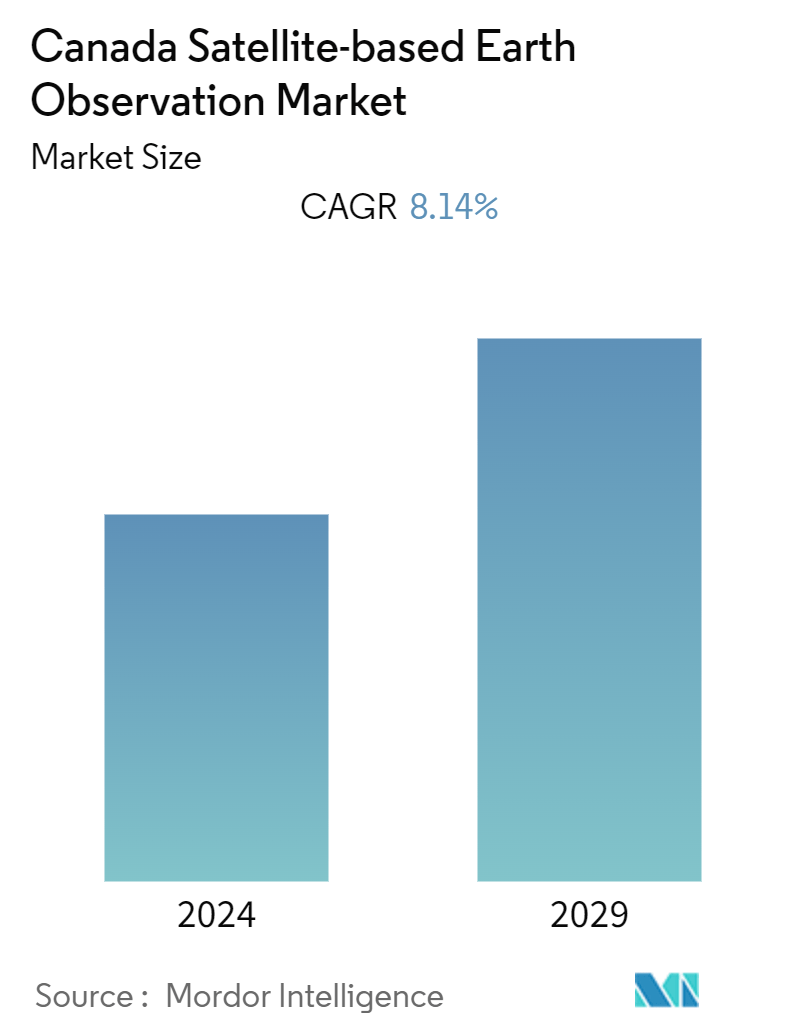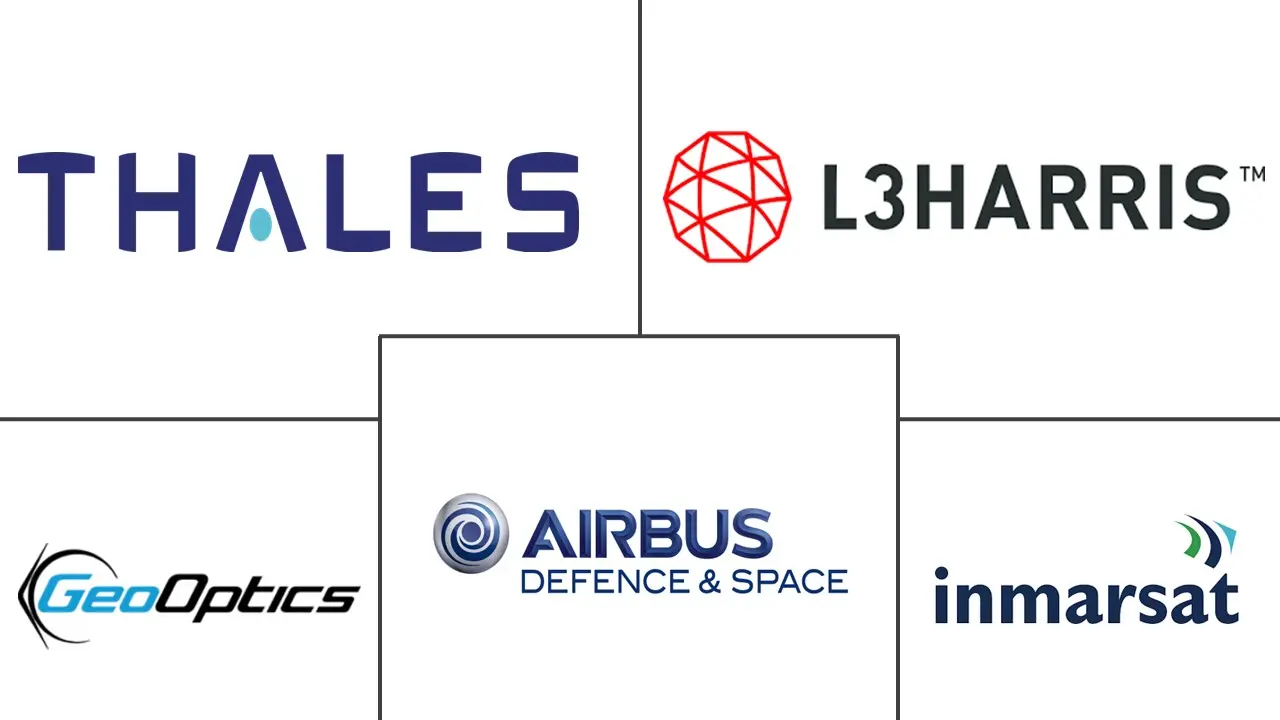Market Size of Canada Satellite-based Earth Observation Industry

| Study Period | 2019 - 2029 |
| Base Year For Estimation | 2023 |
| Forecast Data Period | 2024 - 2029 |
| Historical Data Period | 2019 - 2022 |
| CAGR (2024 - 2029) | 8.14 % |
| Market Concentration | High |
Major Players
*Disclaimer: Major Players sorted in no particular order |
Canada Satellite-based Earth Observation Market Analysis
The Canada Satellite-based Earth Observation Market is expected to register a CAGR of 8.14% during the forecast period.
The Canadian Space Agency (CSA) has supported several satellite missions, including RADARSAT-1, RADARSAT-2, and RADARSAT Constellation Mission (RCM). These satellites provide valuable data for various applications, such as environmental monitoring, resource management, disaster management, and maritime surveillance.
- The rapid advancement in satellite technology has been a major catalyst for the growth of the Earth observation market in Canada. The development of high-resolution imaging sensors, hyperspectral sensors, and synthetic aperture radar (SAR) systems has significantly improved the capabilities of satellites in capturing detailed and accurate data. This technological progress has expanded the range of applications for satellite-based Earth observation, attracting various industries and government agencies to leverage these capabilities for their operations and decision-making processes.
- The increasing demand for geospatial data is another driving force behind Canada's satellite-based Earth observation market growth. Geospatial data provides valuable insights into the Earth's surface, enabling better planning, resource management, and informed decision-making. Industries such as agriculture, forestry, mining, energy, and infrastructure heavily rely on geospatial data for optimizing operations, assessing risks, and identifying potential opportunities. Additionally, government agencies require accurate geospatial data for policy formulation, land management, and environmental monitoring.
- Moreover, the Canadian government has recognized the importance of satellite-based Earth observation and has taken initiatives to promote its growth. Government agencies, such as the Canadian Space Agency (CSA) and Natural Resources Canada (NRCan), actively support research and development in satellite technology, data processing, and analysis. These agencies collaborate with industry players, academic institutions, and international organizations to foster innovation, knowledge exchange, and market development. Government support and partnerships have created a favorable environment for the growth of the satellite-based Earth observation market.
- Canada launched a satellite earth observation plan in 2022, including an investment of USD 8 million in 21 organizations throughout the country to pursue new applications focusing on Earth observation problems and sustainable development goals. The money will be provided through the Canadian Space Agency's (CSA) smartEarth program, which is intended to push Canadian organizations to solve challenges using satellite data and contribute to the resolution of actual problems on Earth.
Canada Satellite-based Earth Observation Industry Segmentation
Canada satellite-based earth observation is done with the help of satellites orbiting around the planet to view and identify environmental changes, map making, etc. The satellite-based earth observation technology captures and stores information from satellites relating to the physical, biological, and chemical compositions of the Earth for monitoring, surveillance, and decision-making in various verticals, such as defense and intelligence, infrastructure and engineering, natural resource management, energy and power, and disaster management.
Canada's satellite-based earth observation market is segmented by type (earth observation data and value-added services), by satellite orbit (low earth orbit, medium earth orbit, and geostationary orbit), and by end-use(urban development and cultural heritage, agriculture, climate services, energy and raw materials, infrastructure, and other end-users).
The market sizes and forecasts are provided in terms of value (USD) for all the above segments.
Canada Satellite-based Earth Observation Market Size Summary
The Canada satellite-based earth observation market is experiencing significant growth, driven by advancements in satellite technology and increasing demand for geospatial data. The Canadian Space Agency has been instrumental in supporting various satellite missions, such as RADARSAT-1, RADARSAT-2, and the RADARSAT Constellation Mission, which provide critical data for applications including environmental monitoring, resource management, and disaster response. The development of high-resolution imaging sensors, hyperspectral sensors, and synthetic aperture radar systems has enhanced the capabilities of satellites, expanding their applications across industries like agriculture, forestry, mining, and energy. This technological progress, coupled with government initiatives and investments, has created a conducive environment for market expansion, with a focus on innovation and collaboration among industry players, academic institutions, and international organizations.
The integration of artificial intelligence and machine learning with satellite data analysis is revolutionizing the way geospatial data is utilized, enabling automated processes that enhance decision-making and operational efficiency. The Canadian government continues to invest in satellite technology development, supporting projects that address earth observation challenges and sustainable development goals. Key players in the market, such as Airbus Defense and Space, MDA Corporation, and Planet Labs Inc., are actively engaging in partnerships and innovations to strengthen their market position. The market's consolidation is evident through strategic collaborations and funding initiatives, such as the Canadian Space Agency's contract with ExactEarth Ltd. for wildfire monitoring and the financial support for NASA-led atmospheric monitoring systems. These efforts underscore Canada's commitment to advancing satellite-based earth observation technologies and their applications across various sectors.
Canada Satellite-based Earth Observation Market Size - Table of Contents
-
1. MARKET INSIGHTS
-
1.1 Market Overview
-
1.2 Industry Attractiveness - Porter's Five Forces Analysis
-
1.2.1 Bargaining Power of Buyers
-
1.2.2 Bargaining Power of Suppliers
-
1.2.3 Threat of New Entrants
-
1.2.4 Threat of Substitutes
-
1.2.5 Intensity of Competitive Rivalry
-
-
1.3 Industry Value Chain Analysis
-
1.4 Assessment of the Impact of COVID-19 on the Market
-
-
2. MARKET SEGMENTATION
-
2.1 By Type
-
2.1.1 Earth Observation Data
-
2.1.2 Value Added Services
-
-
2.2 By Satellite Orbit
-
2.2.1 Low Earth Orbit
-
2.2.2 Medium Earth Orbit
-
2.2.3 Geostationary Orbit
-
-
2.3 By End-Users
-
2.3.1 Urban Development and Cultural Heritage
-
2.3.2 Agriculture
-
2.3.3 Climate Services
-
2.3.4 Energy and Raw Materials
-
2.3.5 Infrastructure
-
2.3.6 Other End-Users
-
-
Canada Satellite-based Earth Observation Market Size FAQs
What is the current Canada Satellite-based Earth Observation Market size?
The Canada Satellite-based Earth Observation Market is projected to register a CAGR of 8.14% during the forecast period (2024-2029)
Who are the key players in Canada Satellite-based Earth Observation Market?
Airbus Defense and Space, Geo Optics Inc., MDA Corporation (Maxar Technologies), Planet Labs Inc. and Inmarsat plc. are the major companies operating in the Canada Satellite-based Earth Observation Market.

